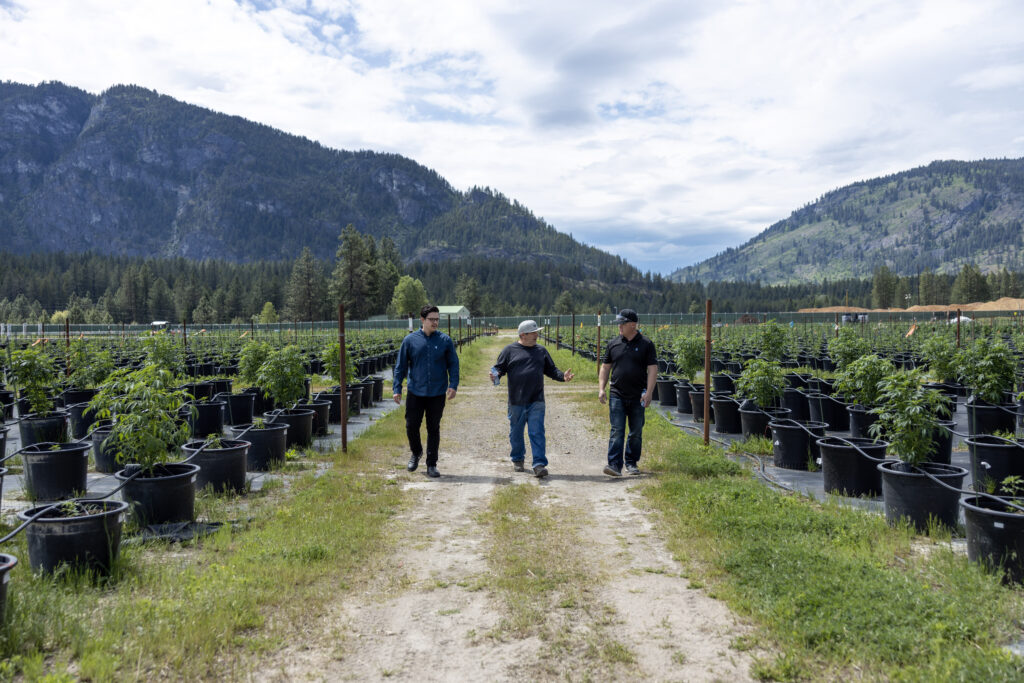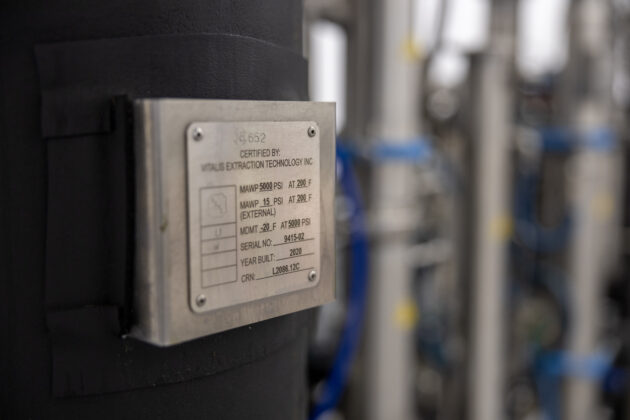
Features
Business
Regulations
Testing
WorkSafeBC: Collaborating to improve health and safety in the cannabis sector
This edition of the Health & Safety column details hazards and risks associated with the extraction process in cannabis.
February 9, 2023 By WorkSafeBC
 Vitalis Extraction Technology's Daniel Paul, senior manager, production and service (left), and Andy Kastak, field service technician (right), discuss extraction equipment with Stuart McGregor, Christina Lake Cannabis' extraction manager. Photo: WorkSafeBC
Vitalis Extraction Technology's Daniel Paul, senior manager, production and service (left), and Andy Kastak, field service technician (right), discuss extraction equipment with Stuart McGregor, Christina Lake Cannabis' extraction manager. Photo: WorkSafeBC By Marnie Douglas
While it is sophisticated and dynamic, the cannabis industry can also be hazardous. Employers and workers need to stay aware of the risks involved in the cultivation and production of cannabis.
Far from being a backyard operation with a few plants growing in a greenhouse, the cannabis industry is a high-tech manufacturing business with specialized components, one of which is extraction. As the industry expands, so too does product development and the market for a variety of cannabis products.
While the extraction of regulated cannabis is new, this method has long been used to extract substances such as essential oils, soybase (liquid from soybeans), and coffee. The purpose of extraction is to isolate the various compounds within the cannabis plant. The extract from the plant is what is processed into different products, including vapes, oils, dabs, edibles, topicals, and juices.
Extracting cannabis compounds is complex and requires special equipment operating under high pressure, explains Kimiko Banati, occupational hygiene officer with WorkSafeBC.
“By manipulating temperature and using pressure, different components can be pulled from the plant. The process can use equipment under extremely high pressure — sometimes up to 10,000 pounds per square inch, or psi — so it’s important that employers and employees are aware of the risks and the controls to mitigate those risks,” she says.
Christina Lake Cannabis Corp. opened three years ago with a 32-acre property, including 9,000 square feet of indoor plant propagation space and more than 950,000 square feet of outdoor growing areas. A key part of their business, in addition to growing, is on-site extraction and processing. As with any manufacturing business, this initially meant extensive research into equipment, such as what to buy and where to buy it from.
“Once we refined the business plan and made the decision to expand our production into extraction, we needed to decide where to purchase the equipment. We had safety concerns around pressurized equipment and decided that a Canadian company would work best for us,” explains Jason Taylor, one of the managers with Christina Lake Cannabis.
Partnering for health and safety
That Canadian company would be Kelowna-based Vitalis Extraction Technologies. Taylor says when Christina Lake Cannabis approached Vitalis, they were immediately impressed with Vitalis’s partnership approach. In other words, Vitalis wasn’t about to sell just any equipment without doing their own homework as well.
“Some customers have purchased pressurized equipment before and not considered the requirements. A fair degree of time goes into educating our clients about health and safety, technical, and building requirements,” says James Seabrook, Vitalis’s president and chief technology officer.
Because cannabis production in B.C. is highly regulated, the other ingredient in a successful venture is ensuring that every rule, regulation, and requirement is met. Vitalis underscores the importance of collaborating with clients like Christina Lake Cannabis to make sure the equipment meets their customer’s needs and ticks the regulatory boxes. Customers need assurance that their manufacturers are providing equipment that is safe for workers during operations. Says Seabrook: “Education is key.”
“Understanding jurisdictional requirements — for us and for our customers — is so important,” he adds.
“We work with high-pressure equipment that comes with a risk of serious injury or death if it doesn’t meet health and safety requirements. At the end of the day, our goal is that everyone goes home safe.”
Risk prevention for the win
Vitalis recommends determining who the applicable inspectors and regulatory bodies are very early in the process to ensure compliance. Those requirements can vary widely across Canada and even within B.C., by municipality.
Seabrook adds that doing the research and being informed is a risk-prevention process and will save delays and additional expense down the road. Part of what Vitalis does for customers is help interpret electrical and building codes, “to ensure the products we build and install are safe. Preventive measures will save thousands of dollars in the long run,” he explains.
Technical Safety BC (formerly the BC Safety Authority) oversees the safe installation and operation of technical systems and equipment, such as those involved in cannabis extraction. Their role is to inspect, permit, and sign off on pressurized equipment. Once it’s approved for use, a CSA label is applied.

When this mark is applied to equipment, it means the equipment has been tested against applicable standards by CSA Group technical experts and is certified for use in North America. Photo: WorkSafeBC
From the perspective of Christina Lake Cannabis, Taylor notes that going with a vendor of CSA-approved equipment was a great starting point and that early consultation and cooperation between all the parties — manufacturer, processor, and regulators — was so important in the process. He stresses that planning and collaboration is critical to overall success.
“It’s hard to put a value on the contributions from Vitalis to our safe and successful extraction operations,” says Taylor. “A cross-functional approach is key. You have to rely on your vendor when it comes to this equipment. The validation and implementation plan from Vitalis was critical, and it addressed our health and safety concerns.”
The company could have purchased equipment from the U.S. or another country, but it still would have needed to be certified for use in Canada, and their timeline would have been significantly extended as a result.
Steve Marino, occupational safety officer with WorkSafeBC, says with the growth of the extraction side of the cannabis industry, pressurized equipment is being imported and non-compliant equipment is being installed in production facilities.
Smaller producers aren’t always aware of the equipment requirements, which can lead to possible explosion risks. Other jurisdictions than B.C. may even have different regulatory requirements.
“In a way, Vitalis partners with customers and regulators to add an extra level of comfort that the equipment is safe for operation,” Marino explains.
Adds Seabrook: “Processors don’t know what they don’t know. There is a knowledge gap, and hopefully by working with regulators like Technical Safety BC and WorkSafeBC, we can close that gap.”
This “systems approach” that sees a manufacturer working closely with both the end-user and the regulators is exactly what Banati likes to see as a WorkSafeBC prevention officer. The design of the equipment, and how it’s built for, and interacts with, employees and the overall facility makes for a safer work environment.
She cautions though that this approach doesn’t eliminate the risks related to cannabis extraction and processing. It can, however, help employers identify risks and put the best controls in place.
“Cannabis processing has seen large growth over the past few years. We are seeing new employers joining the industry, investing in capital equipment, and hiring workers. It’s essential that they have health and safety knowledge about the hazards and risks in extracting cannabis,” she explains.
What are the risks of cannabis extraction and processing?
In the event of an inadvertent pressure release, a pressure blast could cause serious injury or death. As well, Banati adds that high concentrations of carbon dioxide (CO2) in a pressure release can displace oxygen, causing breathing difficulty that may lead to suffocation. The following are examples of situations in which uncontrolled pressure releases can cause a blast:
- Failure of pressurized equipment components such as sanitary clamps
- Discharge of a pressure relief valve into the facility
- Opening a pressure vessel while it’s under pressure
- Over-pressurizing a system beyond its safe limit
- Clogged gauges or lines, which may mislead operators to believe the system is depressurized
The hazard of pressures associated with this equipment is often overlooked. As a result, controls that can prevent serious injuries or death from a blast may not be implemented.
When employers and employees are assessing risks, they should consider the following elements:
- Extraction methods
- Extraction equipment
- Solvent and/or chemical properties
- Facility design
- Worker interactions
Controlling the risks
Once the risk assessment is completed, those risks identified as high or moderate may require additional controls, following the order of the hierarchy of controls described below. Any unsafe conditions found must be corrected. Due to the nature and use of pressurized equipment in the extraction process, it’s likely that opportunities for elimination and substitution may be limited, but engineering and administrative controls for pressure vessels and systems can be considered.
This article has been reprinted with permission from the November/December 2022 issue of WorkSafe Magazine (© Workers’ Compensation Board). For a free subscription, visit worksafemagazine.com.
Print this page